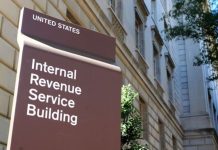March 31 (UPI) — President Joe Biden outlined his $2 trillion infrastructure plan on Wednesday, which includes calling for a shift to greener energy over the next eight years, paid for by raising the corporate tax rate to 28%.
The tax hike would fund the infrastructure plan within 15 years and would be combined with plans to discourage firms from listing tax havens as their address and offshoring profits, the White House outlined in a fact sheet early Wednesday.
As part of the 2017 tax overhaul, Republicans slashed the corporate tax rate from 35% to 21%. Biden’s plan would boost the global minimum tax for multinational corporations and ensure they pay at least 21%.
The plan would also levy a 15% minimum tax on the income the largest corporations report to investors and make it harder for American companies to acquire or merge with a foreign business to avoid paying U.S. taxes.
Biden will announce the proposal, dubbed the American Jobs Plan, on Wednesday at an event in Pittsburgh. He is scheduled to deliver remarks at 4:20 p.m. EDT.
The proposal also aims to:
- Spend $621 billion on bridges, roads, public transit, ports, airports and electric vehicle development. Biden has said the plan will create “really good-paying jobs” and help the nation better compete.
- Invest $174 billion in the electric vehicle market by giving consumers rebates and tax incentives to buy electric vehicles made in America and establish programs to build a national network of 500,000 charging stations by 2030. It would also electrify at least 20% of school buses.
- Allocate $115 billion to modernize 20,000 miles of highways, roads and main streets — and $20 billion to improve road safety and repair the worst 10,000 smaller bridges.
- Put more than $300 billion to expand broadband Internet access, upgrade electric grids and improve the nation’s drinking water infrastructure.
- Spend $300 billion to construct and upgrade schools and affordable housing.
- Inject $580 billion into job training, manufacturing and research and development.
- Put $400 billion into care for elderly and disabled Americans.
The total cost of the proposal is about $2 trillion.
Biden has pledged to create union jobs as part of the infrastructure plan. Two years ago, Biden launched his presidential campaign at a union hall in Pittsburgh, which has a strong organized labor presence.
While Democrats and Republicans agree that U.S. infrastructure is in need of repair, Republicans generally oppose tax hikes to pay for the spending proposal.
Democrats will need support from 10 GOP senators to pass Biden’s plan, or will have to again pass the bill through budget reconciliation, which would not require any Republicans to back the plan. Democrats passed Biden’s $1.9 trillion American Rescue Plan under this process.
Wednesday’s proposal is part of the administration’s efforts to help the country emerge from the throes of COVID-19. Biden and progressive Democrats also hope to use the proposal to combat climate change and move to cleaner energy sources.
The nation’s infrastructure has been in need to repair for years. The American Society of Civil Engineers this year gave U.S. infrastructure a grade of C-, and said an additional $2.6 trillion in funding is required over the next decade.
The White House says Biden’s proposal goes beyond just spending on roads and bridges, as it also focuses on the care economy with investments in education and child care.
The plan would provide $400 billion to bolster care-giving for aging and disabled Americans and expand access to long-term care services under Medicaid — eliminating the wait list for hundreds of thousands of people. It would allow more people to receive care at home through community-based services or from family members.
The proposal would also improve wages for home health workers, of whom one in six currently live in poverty, the plan says.
The plan also includes an investment of $85 billion to modernize existing transit and double federal funding for public transit. About $80 billion would go to Amtrak repairs and its Northeast Corridor line between Boston and Washington, D.C.
About $25 billion would be spent for airports and $17 billion for inland waterways, ports and ferries. More than $213 billion would go toward building, renovating and retrofitting more than 2 million homes and housing units. More than 500,000 homes for low- and middle-income homebuyers would be built under the plan.







